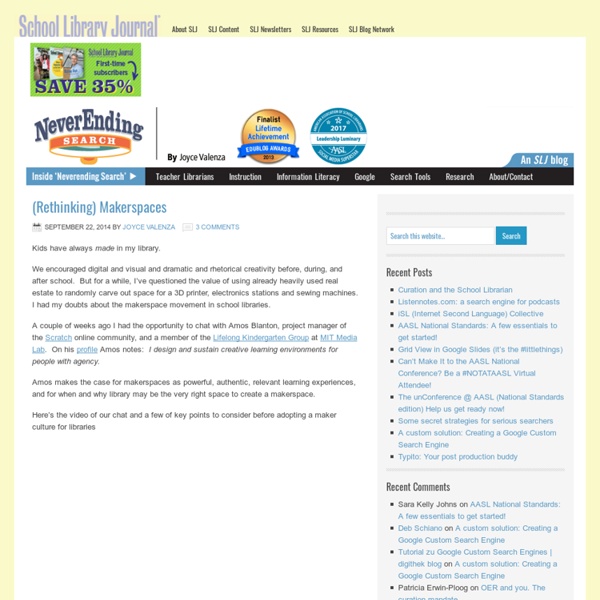Maker Lab Harold Washington Library Center
Contact Us Hours Monday: 1 p.m. to 8 p.m.Tuesday: 1 p.m. to 8 p.m.Wednesday: 1 p.m. to 8 p.m.Thursday: 1 p.m. to 8 p.m.Friday 10 a.m. to 4 p.m.Saturday: 10 a.m. to 4 p.m. Equipment
Designing a School Makerspace
Makerspaces, STEAM labs, and fab labs are popping up in schools across the country. Makerspaces provide hands-on, creative ways to encourage students to design, experiment, build and invent as they deeply engage in science, engineering and tinkering. A makerspace is not solely a science lab, woodshop, computer lab or art room, but it may contain elements found in all of these familiar spaces. Therefore, it must be designed to accommodate a wide range of activities, tools and materials. Diversity and cross-pollination of activities are critical to the design, making and exploration process, and they are what set makerspaces and STEAM labs apart from single-use spaces.
Evolution of a Maker Space, From “Monstie Stuffie” Projects to a Giant Catapult
littleBits activities at the circulation desk in Colleen Graves’s school library. Two years ago, I was asked to write an article for Knowledge Quest about how I created a maker space at Lamar Middle School in Flower Mound, TX. That first year of programming is so different from what I do now that I thought it pertinent to chart how our maker programming (#Makered) has evolved. During my first year as a librarian in 2012–13 my Teen Advisory Board (TAB) helped me redecorate a small office located behind our circulation desk. My director bought us some reading rockers, chalkboard paint, rain gutters, and 25 licenses for Minecraft.
How Fair Is Your Maker Space?
All students should be able to benefit from maker spaces and maker education, which emphasize student-driven learning and foster the development of 21st-century skills. However, not all maker spaces and activities are created equal. Some feature high-tech equipment such as 3-D printers and scanners, programmable robots, mini-computers, and high-tech construction toys—equipment carrying a hefty price tag that not all schools can afford. In addition, maker space activities may cater to certain kids’ interests but not others—including dynamics that educators might not even be aware of. Plus, is self-directed learning the best type for all kids? Here are answers and ways to address these issues.
Makerspaces: On Scanning the Road & Gently Easing the Brakes
As school librarians, we are driven by our mission and our vision, by our national standards, by the needs and interests of our communities, and to some degree, by our own talents, passions and dispositions. We are all about inspiring learners to think, create, share and grow. We are all about becoming empowered leaders who transform teaching and learning. But, there is NOT just one right way to do library. And there is not one right way to inspire creative culture.
Detroit Public Library
The HYPE Teen Center is a place where the passions of young adults are inspired through the spirit of invention, creativity, learning, and do-it-yourself (DIY) culture. The HYPE Makerspace within the HYPE Teen Center was created through a generous grant from the Cognizant – Making the Future initiative in April of 2012. Young adults work in groups with expert instructors during our weekly workshops.
Maker Ed's Resource Library
» Become a Sponsor Disclaimer: Maker Ed’s online Resource Library contains links to third-party organizations, companies, and commercial products. By including these resources, Maker Ed intends to highlight their potential value to the maker education community, rather than to provide an endorsement. The library is independently managed by Maker Ed staff, who adhere to a set of guidelines to ensure that all third-party resources are primarily informational, rather than promotional, in nature. This resource curation process is free from the influence or control of any party outside of Maker Ed.
Baby Steps to creating a Makerspace in the Library
Makerspaces in Your Library When I entered Fields Elementary Library, it was traditional in every way. Slowly, I have worked to make it a learning space, one where I can share technology and create a community of shared learning. Gone are the days that the library is just a place to check in and check out books. Since McAllen ISD is a 1:1 district, I am thrilled to see the potential every student has in this space. When I interviewed a month ago for this library position, my principal asked what my vision was for the library.
How to Start a Makerspace When You're Broke
Everyone’s Favorite Excuse I’ve had the honor and privilege of sharing with hundreds of librarians and educators about our makerspace. Unfortunately, I see many educators hold back on starting a makerspace because of funds. I’m always hearing excuses like:
5 Keys to Rigorous Project-Based Learning
Five Keys Video Series See Edutopia's core strategies in action with our Five Keys video series. Take a deeper look at each strategy as we share the nuts and bolts of program implementation, give voice to examples from schools around the country, and illuminate the research behind the practices. VIDEO: Establishing Real-World Connections in Projects (Keys to PBL Series Part 1) Students are more engaged when learning relates directly to the world they live in. See how to extend your projects beyond classroom walls.



